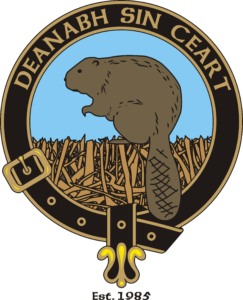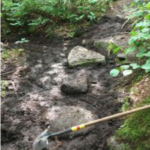What We’ve Been Up To
What We’ve Been Up To in 2015
This year we hosted the summer crew leaders’ school for the Student Conservation Association (SCA) on Mt. Sunapee where the SCA taught them the skills they then taught others around the USA this summer. I flagged a section of new trail to bypass an eroded part of trail that goes straight up the mountain. The relocation takes a wide swing away from the old route and doubles back on a gentle grade. When it opens it will prevent further erosion of the old route as well as being easier to walk. To slow down erosion on the new section we have added 37 new rock steps on the steeper bits of the relo. We also built a 10-rock staircase where a trail climbs a steep slope to a seasonal brook, as well as a few new rock waterbars. These are the fixtures in these photos. We had lots of fun building them, and we invite you to come join us for more of it.
Trail tenders perform two kinds of work: routine upkeep and building fixtures. The routine includes cleaning drains, chopping fallen trees, painting blazes to guide hikers, and cutting back the brush from the side of the trail. We build fixtures like steps, waterbars, revetting, bridges etc. mainly to prevent soil erosion by separating the walkers from the water. That means both parties have to cooperate, so we try to make the fixtures easier for the hiker to use than to avoid.
More practically, we build steps and waterbars on steeper slopes so that each complements the other: steps hold soil on the trail and waterbars shed runoff before it can gain such velocity as to undermine and wash away steps. Rock is the preferred material, but we have to harvest materials from nearby. Wood has a useful life of about 12-15 years on average, rock lasts a little longer.
Waterbars cross the trail at about a 45 degree angle and extend beyond both edges of the trail. The bar is about a foot downhill of the ditch that carries water, so water doesn’t erode the waterbar. The ditch is a foot wide with sloping sides, and we clean it by sliding a shovel up from the downstream end to throw mineral soil back on the trail tread where hikers pack it into a durable surface.
Steps should have the same measurements as stairs at home: a rise of 7″ and a run of 11.” Most of them are higher and a few are shorter, but we try to meet that standard so as to make climbing them easy so the hiker will use them instead of eroding organic soil going through the woods. With all that said, here are some photos of our work on Mt. Sunapee July 11 – August 31.

